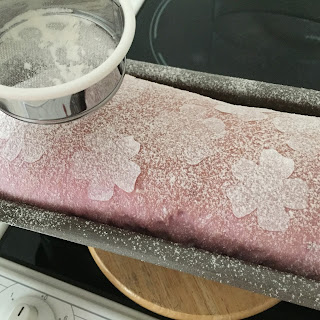I have a few bread recipes using purple sweet potato. However, this is the first time I used the cold fermentation method for this type of bread.
Breads added with purple sweet potato, has rich antioxidant - anthocyanin (though not sure how much still survived after all the steaming and baking). It not only gave the bread a nice pinkish colour, but also a soft texture that can last for days.
Breads added with purple sweet potato, has rich antioxidant - anthocyanin (though not sure how much still survived after all the steaming and baking). It not only gave the bread a nice pinkish colour, but also a soft texture that can last for days.
I used this type of Vietnamese purple sweet potatoes for this recipe.
Yield: one 26x10x10 cm bread
Breadmaker: Mayer MMBM12
Bread weight: 502 g
Raw dough: about 542 g
Ingredients
60g cold fresh milk
60+10g cold water*
20g beaten egg
35g fine sugar
2g fine salt, 1/4 tsp
20g coconut oil
235g Prima bread flour
100g steamed purple sweet potato paste
1/2 tsp instant dry yeast
* as the liquid content of different origin sweet potato is different, so the additional 10g of water will be added depending on the dough condition.
Garnishing
Some remaining bread flour used for dusting
Direction
1. Steamed about 130g of peeled purple sweet potato chunks with pandan leaf (optional) in medium high heat for 20 minuets, or till a thin skewer can poke through easily.
2. Remove the pandan leaves. While the sweet potato is still hot, mash it using a fork. Collect 100g of purple sweet potato paste.
3. Pour ingredients, except the 10g of extra water, into the bread pan following the sequence listed.
4. Place the bread pan back to the bread machine.
Close the lid and select "C-11 Ferment Dough" function, and start the process. Terminate the process manually when the countdown timer reads "0:45".
About 10 minutes after the kneading starts, if the dough is too dry, slowly add in the extra 10g of water.
How to tell if the dough is too dry? If the kneading dough just spin round the axis without the folding action, then the dough is too dry.
5. When the countdown timer reads "0:45", the kneading blade will do about 5 rotations. Stop the process manually after the rotations, by pressing the "Start/Stop" button till you hear a long beep.
6. Coat a plastic bag with a little oil, and transfer the dough into it. Tie a loose knot at the end.
30 minutes later
6. Coat a plastic bag with a little oil, and transfer the dough into it. Tie a loose knot at the end.
Allow the dough to proof for about 30 minutes in room temperature.
30 minutes later
Add another plastic bag outside, place in a big mixing bowl, close the lid and transfer to the fridge to undergo cold fermentation.
I keep the dough in the fridge for about 18 hours, went in at 1pm and came out at 7 am the next morning.
7. Transfer the dough out of the fridge about 1 hour before shaping. Remove the outer plastic bag, invert the dough and let it thaw a room temperature for about 1 hour.
8. After thawing, turn out the dough from the plastic bag onto a floured worktop. Flatten the dough to release the trapped air.
It's alright if the dough is still cold.
Fold in the four sides towards the centre.
Flip over the dough, cover with a lid, and let it rest for about 20 minutes.
9. Roll out the dough into about a 1-cm thick rectangular shape. The shorter width should correspond to the longer length of a 26x10x6.5cm loaf pan.
Flip over the dough, so the smoother side would be facing out after rolling up later.
Roll up the dough and, at the same time, pinch the sides to seal.
10. Spray some water over the dough and place it in a closed oven.
Let the dough proof in a warm oven for about 60 to 90 minutes, or till the dough rises to almost 2 to 3 cm above the rim of the pan.
To facilitates the second proofing, you may switch on the oven to its minimal temperature for about 1 minute.


While waiting for the dough to proof, you may want to cut some stencils using parchment paper for decorating the dough later. The pattern is optional.
11. After the second proofing, remove the dough out of the oven. Preheat the oven to 170 degree Celsius.
Spray a thin coat of water over the paper stencils and "paste" them over the dough surface.
12. Bake the dough at the lower rack of the oven at 170 degree Celsius for about 40 to 50 minutes.
13. Remove the bread from the pan immediately after leaving the oven. Let the loaf cool down on a wire rack before slicing it.



















































No comments:
Post a Comment
I love seeing your comment and sharing it with other readers. Your comment would be published after moderation. Thank you :)